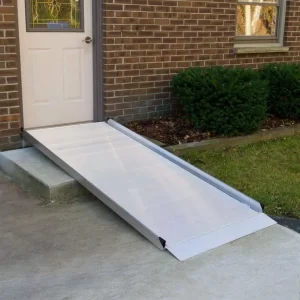Walking assistant devices are a great way to help older people stay active and independent. Walking is one of the best exercises that we can do, but as we age, our bodies change. We often experience pain or stiffness in joints, difficulty climbing stairs, increased fatigue, and balance changes. Mobility aids offer many benefits to those with mobility issues associated with aging by providing extra support while walking. In this article, you will find product reviews on walking assistive devices for the elderly, as well as tips on how to choose the right device for you!
What Is a Walking Assistance Device?
A walking assistant device is typically used by people with limited mobility, such as the elderly, or when someone needs assistance walking and climbing over obstacles. It can also have other functions like aiding in personal hygiene (i.e., washing their hair) and providing support during tasks like dressing or grooming.
Common Walking Assistance Devices for the Ambulatory People
Some mobility aids are more common than others. The most popular are a cane, crutches, walkers, rollators, and activator poles.
Canes for the Ambulatory Elderly
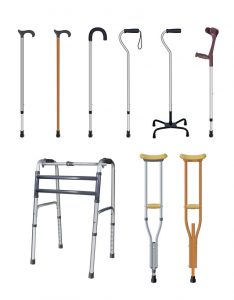
A cane may be one of the most common forms of walking assistance devices for the elderly, which helps provide stability while they walk and just being able to reach an item from across the room on a high shelf.
Walking cane can help with walking stability and support those who either have difficulty standing on their own two feet without assistance or need something more than just crutches to walk around with.
Quad Canes
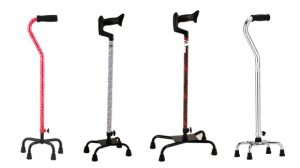
For those who have a walking cane and need assistance with stability when they sit down or stand up from a chair, then quad canes may be an option. They can help someone get in and out of their seat and prevent them from falling.
Quad cane styles: there are different types of quad canes, including folding models which make it easy to take on the go, ergonomic options like ones covered with rubberized foam grips, or even hand-held versions for convenience.
Forearm Canes
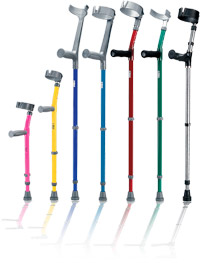
Forearm walking assist devices are another alternative to walking canes. They can be used by those who have difficulty using their hands or arms due to a disability and need assistance with walking. Forearm canes for the ambulatory elderly come in different heights, which is essential for stability, especially getting up from sitting down or standing up from a chair. Some flexible models allow you to move your arm at an angle, so they don’t interfere while reaching out and grabbing something like a doorknob on one side of the doorframe while you’re trying to open it.
The most popular forearm walking assistance device would be The Foresight Forearm Walker Cane Liner (inclined grip) which can be used in a pinch when you don’t have the other devices with you.
When storing your walking assist devices after each use, make sure they are dry before packing them away.
Adjustable Canes
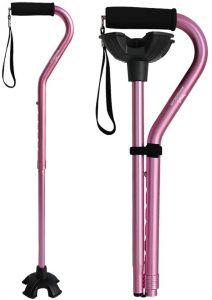
Adjustable walking canes are devices that can be adjusted to the height of those who need them.
When adjusting your walking cane, make sure you’re putting them on a flat surface and then place your other hand on top for support when turning the knob as it allows you to grip more securely than holding onto the cane by itself with one hand. You will hear clicks as you turn, and this helps ensure each notch is in its proper position.
How Much Does an Adjustable Walking Aid Cost? Prices vary depending on what type of walking assist device they’re used for (i.e., quad cane vs. forearm) but typically start at around $60 or less, making them affordable for the elderly.
Crutches
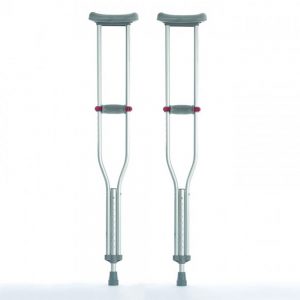
Crutches are used by those who cannot place weight on one of their legs.
Types of crutch Walking Assist Devices: there is a variety, including folding models and adjustable height options. When selecting between the different types, it’s important to consider the most comfortable for you when using them during your day-to-day activities or tasks involving walking.
Some popular walking crutch brands include Drive Medical in Folding Models (i.e., The Heavy Duty Aluminum Adjustable Height Cane with Offset Handle), which can adjust from 30″ – 42″. Another option might be Northrock Healthcare Ergonomic Forearm Walking Crutch because they’re made from durable materials that are also comfortable for the arm.

Ready to get up and get out of the house? Relieve your sore feet with Hugo Lightweight Adjustable Aluminum Crutches.
- light but supporting up to 300 pounds;
- thick cushioned underarm pads;
- washable hand grips;
- featured dual push-button adjustments.
- the handgrip area is narrow ( 3 15/16 inches).
Walkers
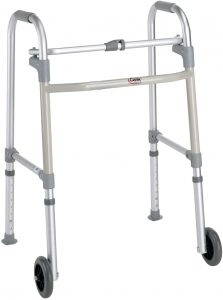
Walkers allow those with a certain mobility impairment to maintain their independence and are especially common among the elderly. Walkers come in different shapes, sizes, colors, types of handles (i.e., cane vs. forearm) but can also be customized based on your needs which is essential when it comes to things like personalized comfort and preventing injury while you’re using them.
Some popular options include the Northrock Healthcare Ergonomic Walking Walker (made of durable materials). It can’t tip over and has an adjustable height option.
Storing your walking assist devices: always make sure they’re dry before packing them away because humidity could cause mold growth, and this device won’t last long if moisture gets trapped in there. This also prevents rust from occurring after prolonged use outdoors, where you might leave your cane outside at night while watching TV.
Rollators
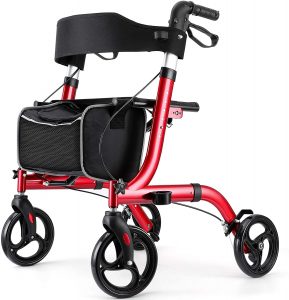
What makes rollator Walking Assist Devices stand out? They come in different heights and colors. Also, they can fold up for easy transport when not in use. That is essential if you’re traveling or moving around various locations outside of your home.
You might want things like handgrips on either side, wheels with locks, and even a seat depending on what type of impairment(s) someone has since these features make life easier and more convenient for people who need them!
Some popular options include Northrock Healthcare Rollator Walking Frames (with a built-in seat and rubber tips on foldable legs) or the Drive Medical Walking Rollator (lightweight with a push-button for an easy, comfortable sitting experience).
Activator Pole
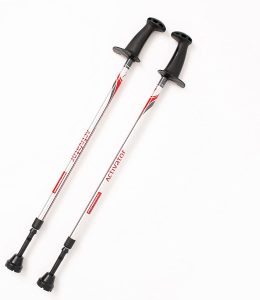
Many people might think that this device is a cane, but the activator walking sticks are different – they have an adjustable height and can be used to walk on surfaces like grass without sinking into it.
The Drive Medical Activator Walking Stick (with offset handle) would work well for someone who needs help with stability when walking because it’s lightweight yet durable at the same time. It also has rubber tips just in case you need to go outside during rain or snow where there may be iced over the ground, as well as slip-resistant feet, which makes them easy to use no matter outdoors what season we’re in!
For Non-Ambulatory Elderly
If you have an older adult who can no longer walk and requires assistance, various walking assist devices could work for them.
Manual Wheelchairs
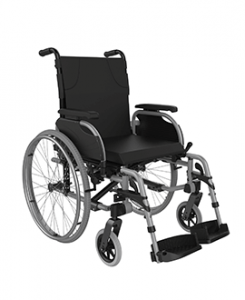
Manual wheelchairs have been around for over 100 years now – they’re lightweight and easily transportable, which is useful when it comes to packing up your things while also maintaining your independence.
Some popular options include Northrock Healthcare Mobility Wheelchair (with a seat) or the Drive Medical Hercules Electric Power Chair (an integrated battery charger).
Power Wheelchair
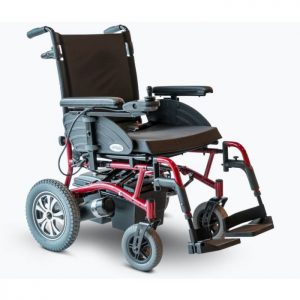
Power wheelchairs can be expensive, but they are worth it for those who require a lot of mobility assistance.
Some popular options include Northrock Healthcare Power Wheelchair (with an integrated backrest) or the Drive Medical Electric Motion Chair, which comes with two medium-size batteries and has easy-to-use one-touch controls.
The power wheelchair is used in hospitals because it’s lightweight yet durable at the same time, which makes transporting these devices much easier than trying to do so manually – this also prevents staff members from getting injured while moving them around as well!
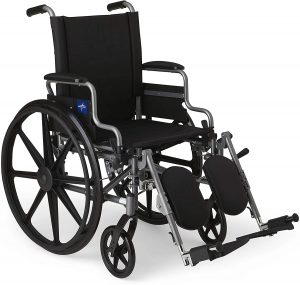
It doesn’t matter what your height or weight is, you deserve the best wheelchair. The Medline Lightweight and User-Friendly Wheelchair have it all:
- foot-powered movement with 2" seat-height adjustments, so you always find the perfect fit;
- durable nylon upholstery that’s easy to clean;
- self-propelling for a light touch;
- flip-back, desk-length for comfortable sitting at tables.
CONs
- is not for the weak: weighing about 40 pounds.
Scooters
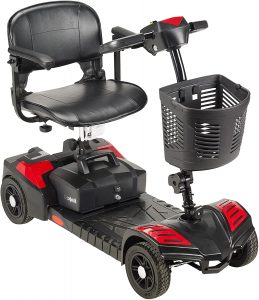
Many people might be tempted to purchase a scooter for elderly individuals because they're cost-effective and easy to use. However, it's important that these devices are used by those who need mobility assistance but can't stand up on their own - if you have balance issues or would benefit more from using the walker walking assist device instead, then this just isn't suitable for them!
Some popular options include Northrock Healthcare Rascal Mobility Scooters (lightweight) and the Drive Medical Tourist Scooters, which come in different colors and an anti-tip design with rubber tips. Hence, there's less chance of accidents occurring when moving around.
Other Options for Walking Assistance
There are a few other things that might be helpful for the elderly who have a problem with walking:
- ramps
- stairlifts
- handrails
Stairlifts

The stairlift is an excellent device that can be useare lightweight individuals to get up and down the stairs safely.
Some popular options include Northrock Healthcare Stairlifts (which have a built-in seat) or Drive Medical Lifestyle Riser Chair, which comes in different colors and is lightweight for easy mobility.
Stairs are underrated - they're great for exercising! Walking up them helps by providing balance, stability, and strength while also improving cardiovascular health. It's important not to avoid using these devices because it might make things worse than better if you don't use them at all when needed: so don't worry about going backward with your progress when it comes to this matter!
Stairlifts usually come with a remote control or a key switch.
Some people may not want to install these devices themselves, but they can always hire someone who is experienced in this field and will do the installation for them!
The beauty of stairlifts going up, down, left-right - you have complete freedom on where it goes, which means there are no limits as far as mobility assistance when using one of these!
There's also the option of ordering your own customized designs if you want something specific according to what materials you're looking for (wood stairs vs. metal).
Straight vs. Curved Stairlifts
Straight stairlifts are generally used in smaller steps or single units, whereas curved ones can be installed on larger ones.
Curved stairs allow for more mobility and flexibility when it comes to the movement of the chair, so if you have someone who's able to wheel themselves around, this is probably going to be your best option!
It might also help with balance which has been proven as an important part of maintaining stability.
If space is limited (which it usually always is), a straight stairlift will work better because there isn't much room left over at all - but either way, these devices are worth having, no matter how small they may seem!
The safety features that come with both designs make them worthwhile investments.
Ramps
The ramps work well because they're lightweight and durable at the same time, so transporting these devices is made much more accessible than if you were trying to do it manually - this also prevents staff members from getting injured while moving them around as well!
If someone has difficulty walking, they might benefit more from using a ramp instead of a stairlift since there's less chance of falling down the stairs and injuring themselves when going up or down steps. As a bonus, these ramps can also be folded down for easy storage when not in use.
To find the right ramp size to fit your needs, you will need to measure out and see how many inches tall a particular step is - this way, you'll know which ramp works best with that height of stairs!
Some popular options include Northrock Healthcare Walking Ramps (with an integrated shelf) or the Drive Medical Elevating Ramps, which come in various colors such as red or blue.
Handrails
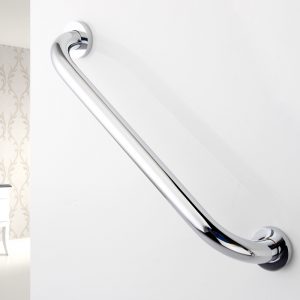
These devices can be used in conjunction with a ramp, stairlift, and more!
Ramps have been shown to improve balance and strength while also aiding with cardiovascular health - so it's no wonder that handrails work well by providing support for anyone who might need them as they move around.
These rails come in different styles: fixed (on both sides) or only at one end. The latter is perfect if you want your elderly friend/family member to feel like their independence has not diminished because of this device!
Honda Walking Assist Device for the Elderly
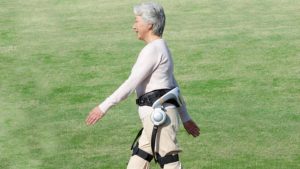
The Honda Walking Assistant device was designed to provide additional support and stability when walking. This can be beneficial for both patients with mobility issues and those recovering from surgery or injury. The best part about this product is that it takes minimal effort on behalf of the user because all they need to do is walk normally while wearing the assistive device.
The Walking Assist Device for Elderly has three components: an ergonomic brace bar that wraps around the waistline; two sidebars that fit under each arm to stabilize movement; and knee pads that come into contact with your legs as you walk, providing extra resistance against slipping forward during a stride.
This device is effective for people with arthritis. It's also easy-to-use - so if you're looking for a way to get around, then this is worth checking out.
Asked Question
A Final Word
If you're an older person, then the decision to purchase a walking assist device may be inevitable. As we age and our bodies change, it becomes more challenging to keep up with things like exercise and mobility that are key for overall health and well-being. In this blog post, we’ve talked about why older people need Walking Assist Devices and how they work to help you make a better decision to purchase one. Have you found anything interesting or surprising? Let us know by leaving your comments below!
